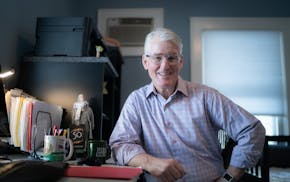About 4 million fewer Americans are in the workforce now than at the start of the year.
This is not about unemployment. About 19 million Americans last week were drawing some sort of unemployment.
I'm talking about dropping out. That means no longer working, no longer looking, no longer being a part of the labor market at all.
And that's worse. More people doing something productive is one of the basic ingredients in the recipe for economic growth.
You are probably thinking that, with vaccines to hold off COVID-19, a return to normal is coming into sight. Yet we are not going back to the way things stood last year, or so said S&P Global Ratings chief economist Paul Gruenwald.
The U.S. job market isn't going to be back to where it was in 2019 for at least four more years. But don't worry, he wrote, the process of creative destruction is already well underway.
Any term with the word "destruction" in it doesn't sound great, but creative destruction can be good. It's the process of new businesses or whole new industries rising up to pick up the assets and workers of businesses in decline or that have already disappeared.
Nobody orchestrates this from Washington or anywhere else, and it's one way the overall economy keeps chugging along.
Yet creative destruction is a terrible thing if you are the one whose job or business just was destroyed and you have to go create a new way to make a living.
This might require moving, going back to school, taking a cut in pay or even all three. Finding new work might take a while, even in an improving labor market.
And for some people over the last few decades, it never happened.
The percentage of Americans 25 to 54 years old in the workforce peaked in the late 1990s at close to 85%. It started dropping in the 2001 recession and didn't come back by the time the next recession happened in 2008. And then it kept declining well after the worst of that recession.
From 1996 to 2016, the American rate of prime working-age men in the workforce slipped from 23rd to 31st out of a ranking of workforce participation in 33 wealthy countries.
For prime-age American women, the decline was much steeper, from 11th in 1996 to 27th by 2016.
Researchers at the Federal Reserve Bank of Dallas were among those who observed all this and knew that other highly developed countries also had jobs disappearing due to globalization and automation, too. They tried to determine what else had been going wrong here.
One conclusion was that America has been the global leader in locking people up, which disrupted the working lives of those caught up in the criminal justice system even if those in prison are normally excluded from the labor-market numbers.
Another is that while in the rest of the world people continued getting healthier and living longer, for a lot of America that was no longer the case. Beginning just before 2000, for white Americans of middle age, mortality rates even stopped declining and then started to increase.
And the U.S. doesn't invest nearly as much in training and other workforce development, only about a sixth as much as the average of more than 30 highly industrialized countries.
Family-friendly policies was another area of stark contrast with other countries, with the U.S. only spending a fraction of what other countries did on child care, family leave and other programs designed, in part, to make it easier for keep people working.
From 2016 through last year, the workforce decline started to reverse as more Americans were attracted back into the workforce.
Yet when the pandemic hit this spring, these problems that had led people to leave the workforce were all still there.
An indicator of overall health might be a number we know from arguments about health care policy, and that's how many non-elderly Americans have what's called a pre-existing health condition. Estimates range to well over 100 million.
Child care has been battered by the coronavirus, too, of course, including by reducing capacity to try to keep staff and kids safer. Yet it's easy to see with in-person school closures just how much workers rely on a safe place for their kids to go during the day. The parents of school-age children I know have all described the last nine months as mostly a stressful, hour-by-hour slog.
Watching a second-grader struggle with Zoom school is distressing, a friend explained over a video meeting this fall, and not because their child is falling behind in school subjects such as math. Trying to do school on a video screen is just a terrible way for a kid to spend the day.
For those parents who must leave the house for their job, no in-person school means stitching together some form of child care or, even worse, deciding there's no practical option other than hoping the kids get by on their own.
It's no surprise, really, that about 2.2 million American women have left the workforce since February, including a big drop in September when school started. The percentage of women working or looking for work has slipped to about what it was back in the 1980s.
This pandemic will wind down and schools will open, but the point of bringing up schools was to remind us that investments in education and child care provide benefits to more than just the kids.
Policymakers can be forgiven if they make direct pandemic aid a priority, but hopefully they will get to investments in child care, flexible family leave and other ways to make it just a little easier for people to stay in the workforce.
The country could use all the productive people going to work it can get. They will be needed to create all the new businesses that can take the place of ones that didn't make it out of the pandemic year.
lee.schafer@startribune.com 612-673-4302

Schafer: What do you really need to retire?

Schafer: How doing business can be a bit more like Christmas morning

Schafer: There won't soon be another opportunity to rethink the I-94 corridor

Schafer: The fruits of Honeywell's long-game dedication to quantum computer now being seen


